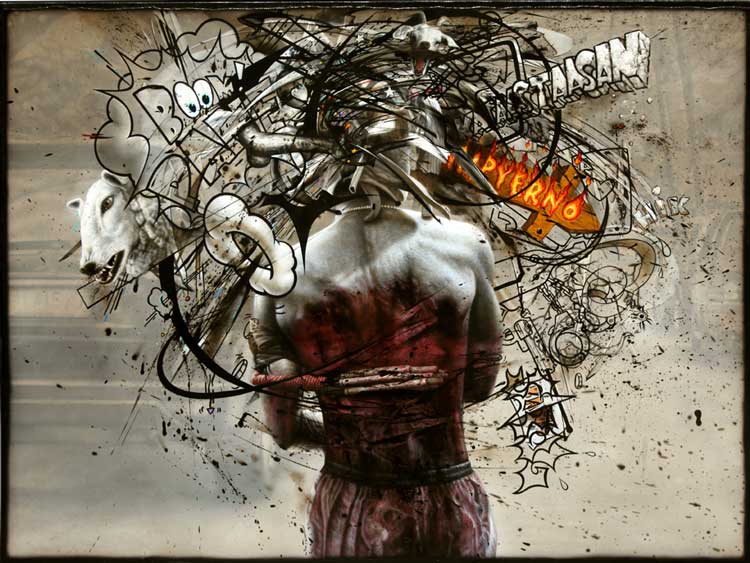Internationally acclaimed artist Ronald Ventura’s third solo exhibition “E.R. (Endless Resurrection)” at Tyler Rollins Fine Art gallery in New York is his strongest yet. Taking on the deep-set rituals of Catholicism in his native Philippines, Ventura’s combination of mediums and virtuoso techniques reveal the significance of religion in his culture while providing a divisive perspective of its impact on Filipino identity.
Continuing with the metaphorical theme of the skin from his prior two exhibitions at the Tyler Rollins gallery that explored the layers of cultural signifiers that come with all individuals, Ventura’s video and slide projection titled E.R. (Endless Resurrection) showcase graphic scenes of self-flagellation and people voluntarily being nailed to the Cross during the period of Lent. Filmed in sepia tone, the red bloody wounds visible on the atoners seeking absolution intensify the charged images of the video.
Similarly, the slide projection depicts locals—inspired by a large billboard-sized reproduction (placed by the artist) of the 17th-century painting The Flagellation of Christ, by Caravaggio—performing outrageous acts of repentance on the street. Shot to reveal the extremities of these rituals, Ventura’s real-life documentations set the tone for his polemical and nuanced oil paintings of conflicting cultural influences predominant in the Philippines.
In Visiting Artist’s Demons and Carne Carnivale, (all works mentioned are from 2014), classical imagery from paintings by European Old Masters such as Hieronymus Bosch and Caravaggio highlight the haunting omnipresence of Catholicism in the artist’s psyche. In the first work, demonic monstrosities resembling the animals from Bosch paintings claw and attack a silent penitent, while in the second, a host of half human half animal-like creatures from a circus gone awry clutter the foreground and obscure the image from Caravaggio’s The Flagellation of Christ visible in the background.
Ventura’s satirical renditions in Cross Turismo and Armor portray the crisis at a different level. Both works showcase a clash among religion, authority and the prevailing influence of global pop culture. Imagery from vintage carnival posters, graffiti, blurbs from comic strips, the local police, and a man prostrate and harnessed to the Cross in Cross Turismo point to a culture in turmoil, while referring to the touristic or entertaining aspect of Catholic rituals. Despite its comical undertone, Ventura’s skillfully executed farcical paintings elicit a strong response from the viewer for the underlying struggle presented through the mash-up of dissonant agencies.
Brought to a climax in the Cross Roads to Nowhere the mental anguish of the sole protagonist who represents his generation is palpable. The man’s tangible bloodied back from penitential lashings appears just below a surreal image of his head that is enveloped in a large halo of jumbled thoughts and images. A cow’s head, newspaper headlines, fluorescent signs of doom and skeletal bones are embodied in a mesh of intertwining wires around the man’s head that reveal the metaphorical layers of skin that people possess. Urban and rural, traditional and modern, religious and secular ideologies seem to coexist with the pull of technology and science.
Ultimately, the weight of his burden and quest for relief from the cultural trauma is embedded in the large sculpture titled Dark Cloud, placed in the front of the gallery. Here, an oversized black fiberglass Cross of Calvary that appears to be made of cotton balls weighs down a man. The irony of this conflicting sculpture, and the possibility this man may need to head to another E.R. (emergency room) in his endless quest for resurrection are not lost on the viewer.
All images courtesy Tyler Rollins Fine Art
Ronald Ventura: E.R. (Endless Resurrection)
September 4 – October 25, 2014
Tyler Rollins Fine Art
529 West 20 Street, 10W
New York, NY 10011



